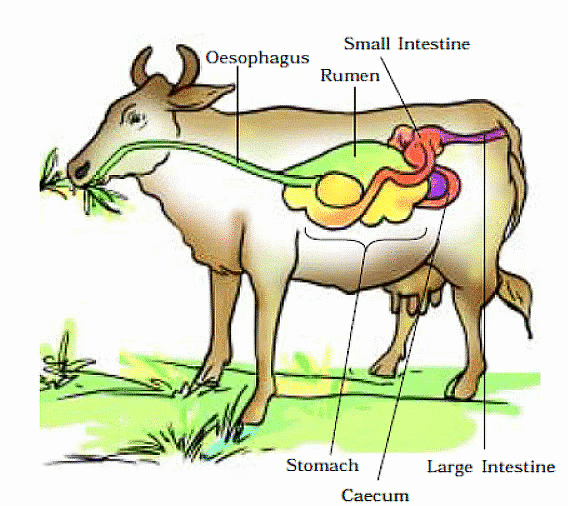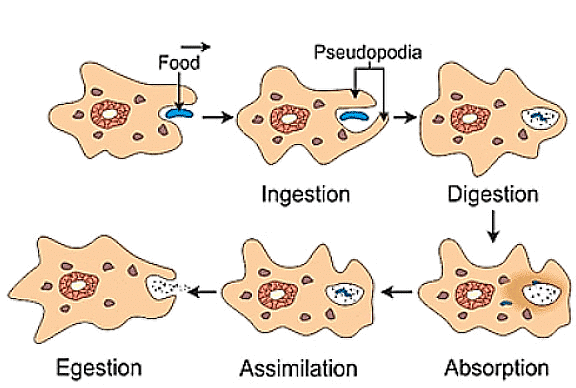Short Notes: Nutrition in Animals | Science Class 7 (Old NCERT) PDF Download
Have you ever thought about how animals get their energy and stay healthy? Just like us, animals need food to grow and function. The way they take in food varies across different species. Some animals eat both plants and other animals. Remember, all living things, including humans, need food for growth, repair, and overall functioning.
In this chapter, we will explore animal nutrition, including the parts of food like carbohydrates, proteins, and fats. Animal nutrition covers the need for nutrients, how food is taken in, and how it is used in the body.

What is Nutrition?
Nutrition is the process of taking in food and turning it into the energy and nutrients needed for an organism to grow and develop.
- Ingestion: This is when food enters the body.
- Digestion: This is when the body breaks down food into simpler forms that can be used.
- Absorption: This is when the body takes the broken-down food and transfers it into the bloodstream.
- Assimilation: This is when the body distributes the absorbed food to various parts.
- Egestion: This is when the body gets rid of waste products.
While plants can create their own food through photosynthesis, animals cannot do this. Animals acquire their food from plants, either directly by consuming them or indirectly by eating other animals that have eaten plants.
What is Nutrition in Animals?
Animal nutrition encompasses understanding the specific nutrients required by different species, how they acquire food, and the processes by which their bodies utilize those nutrients for growth.
Do you know!! The process of breaking down complex components of food, such as carbohydrates, into simpler substances that can be utilized by the body for energy and growth is called digestion.
Different ways of taking food
Animals have various eating methods. For instance, bees and hummingbirds drink nectar from flowers, young animals and many species drink their mother's milk, pythons swallow their prey whole, while some aquatic creatures filter tiny food particles from the water.
Various Modes of Feeding
(i) Chewing: This mode involves the biting and grinding of the food in the mouth by the teeth.
Example - humans, dogs, etc.
(ii) Scraping: In this mode, the food is scraped off the surface by the jaw or an organ.
Examples - snails, ants, etc.
(iii) Siphoning: In this mode, the food is sucked into the mouth.
Example - bees, butterflies, etc.
(iv) Capturing and swallowing: In this mode, they usually capture the food and then swallow it. Example: lizard, etc.
(v) Sucking: This mode involves the piercing of the food and then sucking the liquid out of it.
Example: mosquitoes, etc.
(vi) Sponging: In this mode, the saliva is secreted over the food to dissolve it in order to draw it into the mouth.
Example: houseflies etc.
Note: Starfish consume animals protected by hard calcium carbonate shells by extending their stomachs through their mouths to access the soft animal inside the shell. Subsequently, the stomach retracts into the body, allowing for the gradual digestion of the consumed food.
Digestion in Humans
When we eat, food goes into our mouth and then travels through a long tube inside our body called the digestive tract.
 Human Digestive SystemThis tract is made up of several parts:
Human Digestive SystemThis tract is made up of several parts:
(i) Mouth: Where we chew our food.
(ii) Foodpipe or Esophagus: A tube that carries food from the mouth to the stomach.
(iii) Stomach: A pouch-like organ where food is mixed with digestive juices to break it down further.
(iv) Small Intestine: A long tube where most of the digestion and absorption of nutrients from food happens.
(v) Large Intestine: A wider tube where water and minerals are absorbed from the leftover food.
(vi) Rectum and Anus: Where solid waste, called feces, leaves the body.
As food moves through these parts, it gets broken down into smaller pieces by digestive juices produced by glands like the salivary glands, liver, and pancreas. These juices help turn complex food substances into simpler ones that our bodies can absorb.
What happens to food in different parts of the digestive tract?
1. The mouth and buccal cavity
The buccal cavity is your mouth, where the digestion of carbohydrates, such as starch, starts with the help of your teeth and tongue.

- Food goes into your mouth and gets chewed up by your different teeth.
- Salivary glands in your mouth make saliva, a clear liquid that helps wet and soften the food.
- Your tongue mixes the saliva with the chewed food. It's also got taste buds that let you taste different flavors.
- After chewing, the food forms a ball called a bolus, which moves down your digestive system for more processing.
2. Oesophagus or the food pipe
The oesophagus, also known as the food pipe, is a tube-like structure.

- Partly digested food travels through the oesophagus.
- The walls of the oesophagus push the food downward toward the stomach.
- If our body rejects any food, it's pushed back up through the mouth, which we call vomiting.
3. Stomach
- The stomach is a thick-walled bag shaped like a flattened J, and it is the widest part of the alimentary canal.
- It gets food from the food pipe at one end and connects to the small intestine at the other.
- Inside the stomach, the inner wall makes mucous that protects it, and also produces hydrochloric acid that kills bacteria and helps digestive juices break down food.
- The inner lining secretes mucous, hydrochloric acid, and digestive juices that help in breaking down proteins.
4. Small Intestine
- After the food leaves the stomach, it enters the small intestine, which is a long, coiled tube about 7.5 metres long.
- The small intestine receives bile from the liver to help digest fats and pancreatic juice from the pancreas to assist in digesting carbohydrates and proteins.

- Towards the end of the small intestine, intestinal juice completes the breakdown of food. Carbohydrates turn into glucose, fats change into fatty acids and glycerol, and proteins become amino acids.
- The inner walls of the small intestine have many finger-like projections called villi. The digested food can now enter the blood vessels in the intestine wall, a process known as absorption. These absorbed nutrients are carried to different parts of the body to help build complex substances like proteins needed by the body.
- Inside the cells, glucose is broken down with the help of oxygen into carbon dioxide and water, releasing energy.
5. Large Intestine
- Once the undigested food leaves the small intestine, it enters the large intestine, which is shorter and wider, measuring about 1.5 metres long.
- In the large intestine, water and some salts are absorbed from the undigested food.
- The leftover waste moves into the rectum, where it stays as semi-solid faeces until it is excreted through the anus at intervals.
Digestion in grass-eating animals
Animals like cows and buffaloes eat grass quickly and store it in a special part of their stomach called the rumen. In the rumen, the food is partly digested, forming a substance called cud. Later, this cud comes back into the mouth for gradual chewing. This process is called rumination, and animals that do this are called ruminants.
- The bacteria in the rumen of these grass-eating animals, like cattle, help break down the tough cellulose found in grass.
- Animals like horses and rabbits have a large sac-like structure called the caecum, located between the oesophagus and small intestine, which helps them digest cellulose.

Note: Diarrhoea is when you frequently pass watery stool. It can happen due to infections, food poisoning, or indigestion. It's quite common in India, especially among kids. In severe cases, diarrhoea can be dangerous because it leads to a lot of water and salt loss from the body.
It's important not to ignore diarrhoea. Even before seeing a doctor, the person should drink plenty of boiled and cooled water mixed with a bit of salt and sugar. This mixture is called an Oral Rehydration Solution (ORS).
Feeding and digestion in Amoeba
Amoeba is a tiny, single-celled organism found in pond water that continuously changes its shape using finger-like extensions known as pseudopodia.

- Amoeba consumes its food using its pseudopodia, feeding on various microscopic organisms.
- The food gets enclosed in a food vacuole, where digestive juices are released to break it down into simpler substances.
- Over time, the digested food is absorbed and used for growth, maintenance, and reproduction.
- Any undigested leftover food is expelled from the vacuole.
|
112 videos|435 docs|28 tests
|
FAQs on Short Notes: Nutrition in Animals - Science Class 7 (Old NCERT)
| 1. What is nutrition? |  |
| 2. What is nutrition in animals? |  |
| 3. What are the different ways animals take food? |  |
| 4. How does digestion occur in humans? |  |
| 5. What happens to food in different parts of the digestive tract? |  |
















